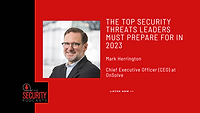How security leaders can prepare for emerging threats

Image via Unsplash
How many security leaders can say they’ve fielded calls about risks posed by a balloon? A few months ago, probably almost zero — today, that number is probably much higher.
For an example of how quickly geopolitical risks can emerge, simply look to the sky. Balloons and other unidentified objects raised tensions within an already strained relationship between the U.S. and China. Security leaders can also look underground — In Peru, an unstable political and economic situation spurred protesters to shut down copper mines, affecting up to 30% of Peru’s copper output.
Because the world is increasingly fast moving and complex, a small ripple in one location can have a wide-ranging impact. Just-in-time supply chains are fragile. Tech workers in areas of unrest or war are in danger. Protests over wages, political legislation and elections are increasing worldwide. New threats are seemingly emerging all the time.
Even companies that have built methods of identifying and managing risk for decades find themselves struggling to keep up with the speed of change in modern times. Here’s what divides the prepared from the not-so-prepared.
Invest in humans
Humans are the bridge between data, AI and historical indicators that create meaningful threat assessments. A healthy ecosystem that works together can respond to risks before they become major threats. It requires the right humans with the right expertise — economic, political, social and environmental — to protect an organization. Experts who have a deep understanding of what influences behaviors or politics can better contextualize the data’s meaning. Taking the time and resources to find the right people is critical to foreseeing emerging threats.
Constantly wargame
Modeling out risk scenarios builds muscle memory, so leadership and organizations know which threats are worth investigating in the first place, as well feeling confident that they’ll be able to respond quickly and efficiently.
With every threat that emerges, there should be a model for the worst-case outcome which should be constantly revisited as data updates. An aperture needs to be as wide as possible to build foresight, and scenario modeling is crucial. While many of those scenarios may never happen, the value of this approach will be proven when just one of them comes to fruition.
Not every balloon that floats by will warrant attention. But when security leaders put together each piece of a security ecosystem, they begin to understand which balloons can disappear into the sky — and which should be shot down.
Looking for a reprint of this article?
From high-res PDFs to custom plaques, order your copy today!









